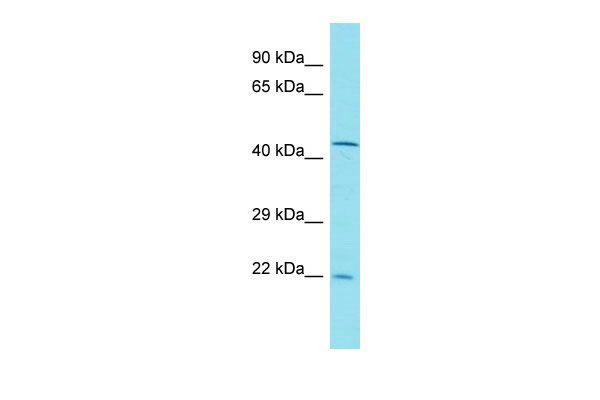ENPP7 Antibody - N-terminal region
Rabbit Polyclonal Antibody
- 产品详情
- 实验流程
- 背景知识
Application
| WB |
|---|---|
| Primary Accession | Q6UWV6 |
| Other Accession | NM_178543, NP_848638 |
| Reactivity | Human, Mouse, Rat |
| Predicted | Human, Mouse, Rat |
| Host | Rabbit |
| Clonality | Polyclonal |
| Calculated MW | 51478 Da |
| Gene ID | 339221 |
|---|---|
| Alias Symbol | ALK-SMase |
| Other Names | Ectonucleotide pyrophosphatase/phosphodiesterase family member 7, E-NPP 7, NPP-7, 3.1.4.12, Alkaline sphingomyelin phosphodiesterase, Intestinal alkaline sphingomyelinase, Alk-SMase, ENPP7 {ECO:0000312|EMBL:AAH41453.2} |
| Format | Liquid. Purified antibody supplied in 1x PBS buffer with 0.09% (w/v) sodium azide and 2% sucrose. |
| Reconstitution & Storage | Add 50 ul of distilled water. Final anti-ENPP7 antibody concentration is 1 mg/ml in PBS buffer with 2% sucrose. For longer periods of storage, store at 20°C. Avoid repeat freeze-thaw cycles. |
| Precautions | ENPP7 Antibody - N-terminal region is for research use only and not for use in diagnostic or therapeutic procedures. |
| Name | ENPP7 {ECO:0000312|EMBL:AAH41453.2, ECO:0000312|HGNC:HGNC:23764} |
|---|---|
| Function | Choline-specific phosphodiesterase that hydrolyzes sphingomyelin releasing the ceramide and phosphocholine and therefore is involved in sphingomyelin digestion, ceramide formation, and fatty acid (FA) absorption in the gastrointestinal tract (PubMed:12671034, PubMed:12885774, PubMed:15205117, PubMed:16255717, PubMed:28292932). Also has phospholipase C activity and can also cleave phosphocholine from palmitoyl lyso-phosphatidylcholine and platelet-activating factor (PAF) leading to its inactivation (PubMed:12885774, PubMed:16255717). Does not have nucleotide pyrophosphatase activity (PubMed:12885774). May promote cholesterol absorption by affecting the levels of sphingomyelin derived from either diet or endogenous sources, in the intestinal lumen (By similarity). |
| Cellular Location | Cell membrane; Single-pass type I membrane protein. Note=The catalytic domain is released into the extracellular medium when cells are treated with trypsin (PubMed:15205117). Localized at the surface of the microvillar membrane in small intestine enterocytes, and in endosome-like structures situated beneath the microvillar membrane, and in Golgi complex (PubMed:12671034, PubMed:12885774) |
| Tissue Location | Detected in the colon (at protein level). Expressed in the duodenum, jejunum and liver and at low levels in the ileum Expression was very low in the esophagus, stomach and colon |
For Research Use Only. Not For Use In Diagnostic Procedures.
Provided below are standard protocols that you may find useful for product applications.
BACKGROUND
Converts sphingomyelin to ceramide. Also has phospholipase C activity toward palmitoyl lyso-phosphocholine. Does not appear to have nucleotide pyrophosphatase activity.
REFERENCES
Duan R.-D.,et al.J. Biol. Chem. 278:38528-38536(2003).
Clark H.F.,et al.Genome Res. 13:2265-2270(2003).
Ota T.,et al.Nat. Genet. 36:40-45(2004).
Zhang Z.,et al.Protein Sci. 13:2819-2824(2004).
Duan R.-D.,et al.J. Lipid Res. 44:1241-1250(2003).
终于等到您。ABCEPTA(百远生物)抗体产品。
点击下方“我要评价 ”按钮提交您的反馈信息,您的反馈和评价是我们最宝贵的财富之一,
我们将在1-3个工作日内处理您的反馈信息。
如有疑问,联系:0512-88856768 tech-china@abcepta.com.























 癌症的基本特征包括细胞增殖、血管生成、迁移、凋亡逃避机制和细胞永生等。找到癌症发生过程中这些通路的关键标记物和对应的抗体用于检测至关重要。
癌症的基本特征包括细胞增殖、血管生成、迁移、凋亡逃避机制和细胞永生等。找到癌症发生过程中这些通路的关键标记物和对应的抗体用于检测至关重要。 为您推荐一个泛素化位点预测神器——泛素化分析工具,可以为您的蛋白的泛素化位点作出预测和评分。
为您推荐一个泛素化位点预测神器——泛素化分析工具,可以为您的蛋白的泛素化位点作出预测和评分。 细胞自噬受体图形绘图工具为你的蛋白的细胞受体结合位点作出预测和评分,识别结合到自噬通路中的蛋白是非常重要的,便于让我们理解自噬在正常生理、病理过程中的作用,如发育、细胞分化、神经退化性疾病、压力条件下、感染和癌症。
细胞自噬受体图形绘图工具为你的蛋白的细胞受体结合位点作出预测和评分,识别结合到自噬通路中的蛋白是非常重要的,便于让我们理解自噬在正常生理、病理过程中的作用,如发育、细胞分化、神经退化性疾病、压力条件下、感染和癌症。






